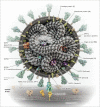Can cilia provide an entry gateway for SARS-CoV-2 to human ciliated cells?
- PMID: 33855870
- PMCID: PMC8213509
- DOI: 10.1152/physiolgenomics.00015.2021
Can cilia provide an entry gateway for SARS-CoV-2 to human ciliated cells?
Abstract
A worldwide coronavirus pandemic is in full swing and, at the time of writing, there are only few treatments that have been successful in clinical trials, but no effective antiviral treatment has been approved. Because of its lethality, it is important to understand the current strain's effects and mechanisms not only in the respiratory system but also in other affected organ systems as well. Past coronavirus outbreaks caused by SARS-CoV and MERS-CoV inflicted life-threatening acute kidney injuries (AKI) on their hosts leading to significant mortality rates, which went somewhat overlooked in the face of the severe respiratory effects. Recent evidence has emphasized renal involvement in SARS-CoV-2, stressing that kidneys are damaged in patients with COVID-19. The mechanism by which this virus inflicts AKI is still unclear, but evidence from other coronavirus strains may hold some clues. Two theories exist for the proposed mechanism of AKI: 1) the AKI is a secondary effect to reduced blood and oxygen levels causing hyperinflammation and 2) the AKI is due to cytotoxic effects. Kidneys express angiotensin-converting enzyme-2 (ACE2), the confirmed SARS-CoV-2 target receptor as well as collectrin, an ACE2 homologue that localizes to the primary cilium, an organelle historically targeted by coronaviruses. Although the available literature suggests that kidney damage is leading to higher mortality rates in patients with COVID-19, especially in those with preexisting kidney and cardiovascular diseases, the pathogenesis of COVID-19 is still being investigated. Here, we present brief literature review supporting our proposed hypothesis of a possible link between SARS-CoV-2 cellular infection and cilia.
Keywords: ACE2; COVID-19; cilia; corona virus.
Conflict of interest statement
No conflicts of interest, financial or otherwise, are declared by the authors.
Figures





Similar articles
-
Kidney organoids reveal redundancy in viral entry pathways during ACE2-dependent SARS-CoV-2 infection.J Virol. 2024 Mar 19;98(3):e0180223. doi: 10.1128/jvi.01802-23. Epub 2024 Feb 9. J Virol. 2024. PMID: 38334329 Free PMC article.
-
Androgens, the kidney, and COVID-19: an opportunity for translational research.Am J Physiol Renal Physiol. 2021 Feb 1;320(2):F243-F248. doi: 10.1152/ajprenal.00601.2020. Epub 2021 Jan 19. Am J Physiol Renal Physiol. 2021. PMID: 33464168 Free PMC article.
-
Relationship Between Severe Acute Respiratory Syndrome Coronavirus 2 (SARS-CoV-2) and the Etiology of Acute Kidney Injury (AKI).Am J Med Sci. 2021 Mar;361(3):287-296. doi: 10.1016/j.amjms.2020.10.025. Epub 2020 Oct 27. Am J Med Sci. 2021. PMID: 33358501 Free PMC article. Review.
-
SARS-CoV-2 ORF3a induces COVID-19-associated kidney injury through HMGB1-mediated cytokine production.mBio. 2024 Nov 13;15(11):e0230824. doi: 10.1128/mbio.02308-24. Epub 2024 Sep 30. mBio. 2024. PMID: 39345136 Free PMC article.
-
The lethal internal face of the coronaviruses: Kidney tropism of the SARS, MERS, and COVID19 viruses.IUBMB Life. 2021 Aug;73(8):1005-1015. doi: 10.1002/iub.2516. Epub 2021 Jun 30. IUBMB Life. 2021. PMID: 34118117 Free PMC article. Review.
Cited by
-
SARS-CoV-2 Infection Dysregulates Cilia and Basal Cell Homeostasis in the Respiratory Epithelium of Hamsters.Int J Mol Sci. 2022 May 4;23(9):5124. doi: 10.3390/ijms23095124. Int J Mol Sci. 2022. PMID: 35563514 Free PMC article.
-
Identification of virus-rich intermediate cells as crucial players in SARS-CoV-2 infection and differentiation dynamics of human airway epithelium.Front Microbiol. 2024 Dec 13;15:1507852. doi: 10.3389/fmicb.2024.1507852. eCollection 2024. Front Microbiol. 2024. PMID: 39735182 Free PMC article.
-
Role of Multifunctional Cytoskeletal Filaments in Coronaviridae Infections: Therapeutic Opportunities for COVID-19 in a Nutshell.Cells. 2021 Jul 19;10(7):1818. doi: 10.3390/cells10071818. Cells. 2021. PMID: 34359986 Free PMC article. Review.
-
MAP3K19 regulatory variation in populations with African ancestry may increase COVID-19 severity.iScience. 2023 Aug 7;26(9):107555. doi: 10.1016/j.isci.2023.107555. eCollection 2023 Sep 15. iScience. 2023. PMID: 37649700 Free PMC article.
-
COVID-19 and Neurological Manifestations.Brain Sci. 2023 Jul 29;13(8):1137. doi: 10.3390/brainsci13081137. Brain Sci. 2023. PMID: 37626493 Free PMC article. Review.
References
Publication types
MeSH terms
Substances
Grants and funding
- R15HL140523/HHS | NIH | National Heart, Lung, and Blood Institute (NHLBI)
- 3R15HL140523-01S1/HHS | NIH | National Heart, Lung, and Blood Institute (NHLBI)
- 19PRE34430055/American Heart Association (AHA)
- 3R15HL140523-01S3/HHS | NIH | National Heart, Lung, and Blood Institute (NHLBI)
- American Foundation for Pharmaceutical Education (AFPE)
LinkOut - more resources
Full Text Sources
Other Literature Sources
Medical
Miscellaneous

